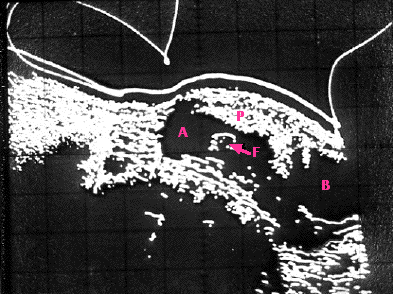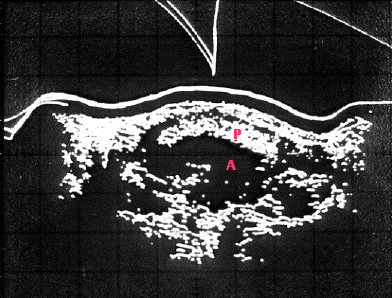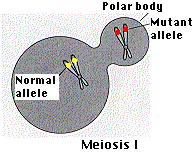

| Index to this page |
Many tests are now available to detect genetic diseases.
Some examples: Most of these tests can not only be performed on cells removed from adults but also on cells removed fromDuring its development, the fetus sheds cells into the amniotic fluid. After 15–20 weeks of pregnancy, a small volume of this fluid can be removed (using a needle inserted through the abdominal wall).
 |  |
| Using ultrasound to locate the position of the placenta prior to amniocentesis. These sonograms are made by recording the echoes received from structures within the abdomen. A, amniotic cavity; B, urinary bladder; F, part of the fetus; P, placenta. Both longitudinal (left) and transverse (right) scans are needed for accurate localization of the placenta. (Courtesy of the Downstate Medical Center of the State University of New York.) | |
Separating the cells and culturing them enables the clinician to look for
This is an alternate method of prenatal diagnosis.
A small amount of placental tissue is sucked out by a tube inserted through the abdominal wall or through the vagina (the latter avoiding the need for an incision).
For some tests the fetal cells can be examined immediately without the need to culture them.
Another advantage of CVS is that it can be performed earlier in pregnancy (after only 10–12 weeks) than amniocentesis. If an abortion is to be performed, it is a simpler process early in pregnancy.
This raises the possibility of using genetic tests (e.g., PCR) to identify mutations or chromosomal abnormalities in the fetus using a small (~10 ml) sample of blood drawn from the mother.
Two home blood test kits for determining the sex of the fetus are already on the market. The collected drops of blood are sent to a laboratory to determine whether any Y-chromosome-specific DNA (e.g., SRY) is present.
Tests of fetal DNA for Down syndrome (trisomy 21), as well as for trisomy 13 and 18, have both higher sensitivity (false negatives <0.1%) and specificity (false positives <0.2%) than amniocentesis and CVS.
In several European countries, Rh-negative mothers can now have their blood screened for the presence of an Rh-positive fetus. The time will surely come when such NIPT screening will become available for many genetic disorders. (The procedure is also called non-invasive prenatal diagnosis — NIPD.)
(The level of fetal DNA in the mother's blood rises to a peak at the time of birth and some evidence suggests that this rise may be a trigger to start the birth process — Link)
One of the remarkable facts about mammalian development is that all the cells in the early (e.g., 8-cell) embryo are not needed to produce a healthy fetus (which is why a single fertilized egg can on occasions produce identical twins, triplets, etc.).
So couples using in vitro fertilization (IVF) also can take advantage of genetic screening. While the embryo is in culture, one or two cells can safely be removed and tested for their genotype. For example:
| In mice, a single cell removed from the 8-cell morula can be used to generate a culture of embryonic stem cells. If this turns out to be true for humans (it does! success was reported in August 2006), it would provide a method of generating these cells without the need to destroy a blastocyst in the process. |
As meiosis I is completed, one set of duplicated chromosomes (dyads) is extruded into the first polar body. The DNA of the polar body can be amplified by the polymerase chain reaction (PCR) and tested.

If the mother is heterozygous for a trait, and no crossover has occurred, and the polar body contains the mutant alleles (see figure), the egg can be safely fertilized. (For simplicity, the figure shows only the pair of homologues carrying the locus of concern.)
However, if crossing over has occurred, the first polar body would contain one mutant and one healthy allele. In that case, there is a 50:50 chance that, after fertilization, the other copy of the mutant allele will end up in the egg (instead of in the second polar body). So the second polar body should also be tested to see if it also contains the mutant allele. Only if it does can the egg be safely used.
| Welcome&Next Search |